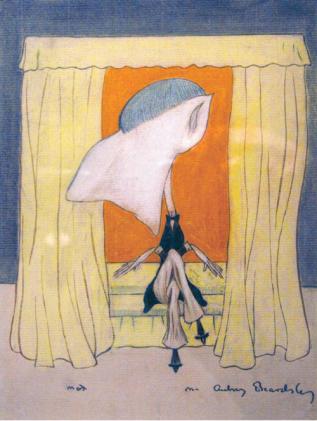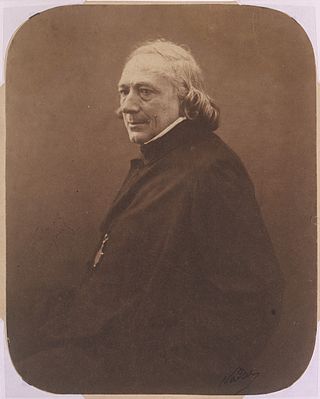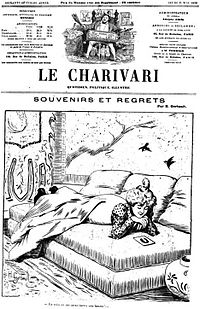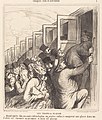
A caricature is a rendered image showing the features of its subject in a simplified or exaggerated way through sketching, pencil strokes, or other artistic drawings. Caricatures can be either insulting or complimentary, and can serve a political purpose, be drawn solely for entertainment, or for a combination of both. Caricatures of politicians are commonly used in newspapers and news magazines as political cartoons, while caricatures of movie stars are often found in entertainment magazines.

Honoré-Victorin Daumier was a French painter, sculptor, and printmaker, whose many works offer commentary on the social and political life in France, from the Revolution of 1830 to the fall of the second Napoleonic Empire in 1870. He earned a living throughout most of his life producing caricatures and cartoons of political figures and satirizing the behavior of his countrymen in newspapers and periodicals, for which he became well known in his lifetime and is still known today. He was a republican democrat who attacked the bourgeoisie, the church, lawyers and the judiciary, politicians, and the monarchy. He was jailed for several months in 1832 after the publication of Gargantua, a particularly offensive and discourteous depiction of King Louis-Philippe.

Jean Ignace Isidore Gerard was a prolific 19th century French illustrator and caricaturist who published under the pseudonym of Grandville. He has been called "the first star of French caricature's great age", and Grandville's book illustrations described as featuring "elements of the symbolic, dreamlike, and incongruous, and they retain a sense of social commentary." "His perverse vision sought the monster in everyone and took delight in the strangest and most pernicious transfigurement of the human shape ever produced by the Romantic imagination." The anthropomorphic vegetables and zoomorphic figures that populated his cartoons anticipated and influenced the work of generations of cartoonists and illustrators from John Tenniel, to Gustave Doré, to Félicien Rops, and Walt Disney. He has also been called a "proto-surrealist" and was greatly admired by André Breton and others in the movement.

Achille Jacques-Jean-Marie Devéria was a French painter and lithographer known for his portraits of famous writers and artists. His younger brother was the Romantic painter Eugène Devéria, and two of his six children were Théodule Devéria and Gabriel Devéria.

Paul Gavarni was the pen name of Sulpice Guillaume Chevalier, a French illustrator, born in Paris.
Rick Tulka is an illustrator and caricaturist whose work has appeared in Mad magazine since 1988. He has been living and working in Paris since the mid-1990s.
Robert Macaire is a fictional character, an unscrupulous swindler, who appears in a number of French plays, films, and other works of art. In French culture he represents an archetypal villain. He was principally the creation of an actor, Frédérick Lemaître, who took the stock figure of "a ragged tramp, a common thief with tattered frock coat patched pants" and transformed him during his performances into "the dapper confidence man, the financial schemer, the juggler of joint-stock companies" that could serve to lampoon financial speculation and government corruption.
Events from the year 1833 in art.

Jean-Louis Forain was a French Impressionist painter and printmaker, working in media including oils, watercolour, pastel, etching and lithograph. Compared to many of his Impressionist colleagues, he was more successful during his lifetime, but his reputation is now much less exalted.

Charles Philipon was a French lithographer, caricaturist and journalist. He was the founder and director of the satirical political journals La Caricature and of Le Charivari.

André Gill was a French caricaturist. Born Louis-Alexandre Gosset de Guînes at Paris, the son of the Comte de Guînes and Sylvie-Adeline Gosset, Gill studied at the Royal Academy of Painting and Sculpture. He adopted the pseudonym André Gill in homage to his hero, James Gillray. Gill began illustrating for Le Journal Amusant, but he became known for his work for the weekly four-sheet newspaper La Lune, edited by Francis Polo, in which he drew portraits for a series entitled The Man of the Day. He worked for La Lune from 1865 to 1868. When La Lune was banned, he worked for the periodical L'Éclipse from 1868 to 1876. Gill also drew for famous periodical Le Charivari.

René Georges Hermann-Paul was a French artist. He was born in Paris and died in Saintes-Maries-de-la-Mer.

Jean-Pierre Dantan, known as Dantan the Younger, was a French portrait sculptor. His subjects include many famous figures from the realms of politics, music and the arts, and literature. He is said to be the inventor of the sculptural caricature.

The Third-Class Carriage is the name of at least three oil paintings entitled made by the French painter Honoré Daumier. In a realistic manner, Daumier depicts the poverty and fortitude of working class travellers in a third class railway carriage. One oil-on canvas version, dated to c. 1862–1864 but left unfinished, is in the collection of the Metropolitan Museum of Art in New York, and a similar but completed painting dated to c. 1863–1865 is in the National Gallery of Canada in Ottawa. A third oil-on-panel version, dated to c. 1856–1858, with a different arrangement of the main three figures, is held by the Fine Arts Museums of San Francisco.

La Caricature was a satirical weekly French periodical that was distributed in Paris between 1830 and 1843 during the July Monarchy. Its cartoons repeatedly attacked King Louis Philippe, whom it typically depicted as a pear.
The Society of the Rights of Man was a French republican association with Jacobin roots, formed during the July Revolution in 1830, replacing another republican association, the Society of the Friends of the People (France). It played a major role in the June riots of 1832 in Paris and the July Monarchy.

Cândido Aragonez de Faria was a Brazilian caricaturist, painter, lithographer and poster designer who emigrated to France in 1882. Faria designed posters for performers in café-chantants and the cinema but also for music scores. The collective art work of his workshop, which continued after his death, was signed Atelier Faria.

Jean-Baptiste Côté was a Canadian architect, wood-carver, glider, wood engraver, caricaturist, publisher, and printer. His reputation rests on his wood engravings, and on his being one of Canada's earliest cartoonists.
Joseph Germain Mathieu Roubaud, called "Benjamin",, the son of Mathieu Aubert Roubaud and Rosalie Caillol, was a 19th-century French painter, lithographer and caricaturist.

Charles-Joseph Traviès de Villers, also known simply as Traviès, was a Swiss-born French painter, lithographer, and caricaturist whose work appeared regularly in Le Charivari and La Caricature. His Panthéon Musical was one of the most famous and widely reproduced musical caricatures of the 19th century. His younger brother was the painter and illustrator Édouard Traviès.





















